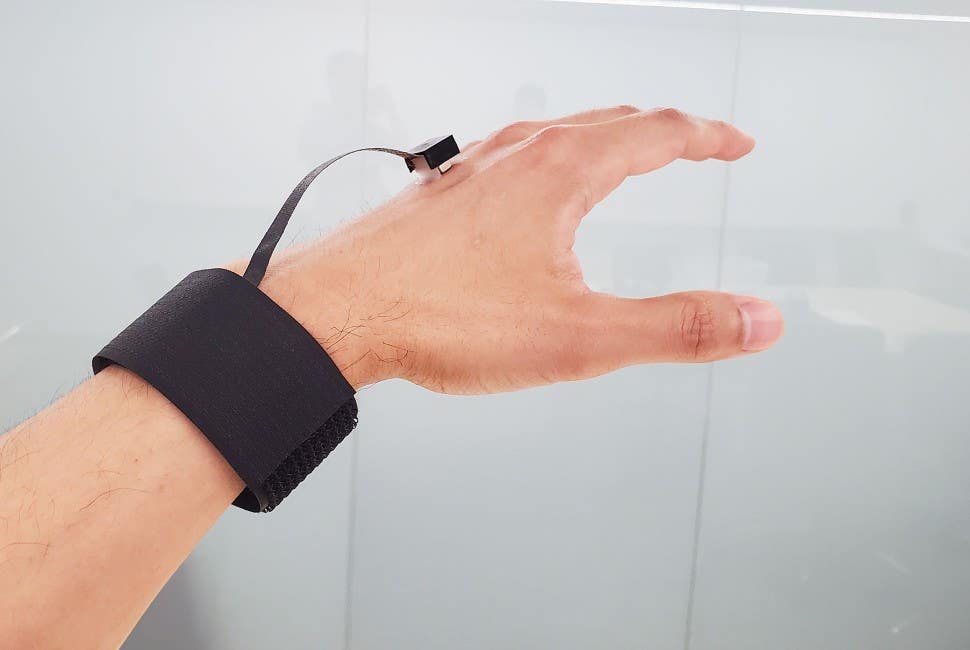Student invents shape-shifting ball that could revolutionize mental health treatment
Researcher has created a soft ball that embodies the very essence of breath, moving in harmony with an individual’s breathing patterns.

[Sept. 3, 2023: Staff Writer, The Brighter Side of News]
Alexz Farrall and his PAWS 'breathing' ball. (CREDIT: University of Bath)
In a major digital advancement, an invention from the University of Bath, UK, is making waves, promising a revolutionary approach to managing mental health.
PhD student Alexz Farrall, in a groundbreaking feat, has created a soft ball that embodies the very essence of breath, moving in harmony with an individual's breathing patterns.
The Essence of the Breathing Ball
At its core, this device serves as a tangible manifestation of one’s inhalations and exhalations. Such a simple concept holds the key to a multitude of mental health benefits, as it allows individuals to visualise, feel, and ultimately connect deeply with their breath.
"By giving breath physical form, the ball enhances self-awareness and engagement, fostering positive mental health outcomes," asserts Farrall.
Related Stories:
The Ignored Art of Breathing
Surprisingly, for an action so essential to life, breathing often flies under our conscious radar. Delving deeper, focused, deep breathing exercises have long been lauded for their therapeutic effects, most notably the ability to assuage anxiety and bolster overall well-being. Professionals in the mental health domain frequently incorporate measured breathing exercises in Cognitive Behavioural Therapy (CBT), Mindfulness-Based Stress Reduction (MBSR), Dialectical Behaviour Therapy (DBT), and trauma-focused therapies.
However, the challenge lies in maintaining prolonged attention on one's breathing. Farrall points out, "Most people struggle to sustain attention on their breathing. Once disengaged from the process, they often revert to a thinking mode, limiting their receptiveness to other mental-health interventions that necessitate concentration."
Recent research spearheaded by Farrall unveils the profound impact of this innovative device. During the study, participants, armed with this shape-shifting ball, exhibited enhanced concentration on their breathing, further facilitating their receptiveness to meditation app guided sessions.
The statistics are compelling. Participants who used the breathing ball witnessed a whopping 75% reduction in anxiety levels and a 56% uplift in their resilience against worry-prone thoughts. Their counterparts who relied solely on the audio guidance observed a 31% dip in anxiety, thus recording 44% heightened anxiety compared to the former group.
Furthermore, the ball+audio amalgamation showcased a pronounced increase in Heart Rate Variability, which correlates with superior stress resistance and emotional equilibrium.
These findings were spotlighted at the esteemed CHI Conference on Human Factors in Computing Systems – an apex forum for discussions on human-computer interaction.
Bridging the Mental Health Support Gap
Expounding on the utility of his invention, Farrall illustrates, "When an individual holds the ball, their breath becomes a tangible entity. They can perceive the ebb and flow of their breath as the ball expands and shrinks. This tactile experience amplifies self-awareness and primes the user for psychological transformation."
The UK’s National Health Service expends an estimated £118 billion annually on mental health-related concerns. Digital platforms, like apps, have emerged to alleviate this burden. Yet, a concerning observation reveals that a mere 3.9% of users consistently engage with a mental health app over a fortnight. The 'Physical Artefact for Well-being Support' (PAWS) – as Farrall's brainchild is christened – presents an enticing solution to this dilemma.
Our constructed shape-changing biofeedback-based pneumatic PAWS inflates and deflates in relation to captured inhalation and exhalation bio-signals. (CREDIT: ACM)
"I envisage this device catalyzing tangible mental health improvements, spanning clinical domains and household settings," Farrall envisages.
Professor Jason Alexander, overseeing Farrall’s project, lauds the initiative, “The allure of PAWS lies in its simplicity – enabling someone to tangibly 'feel' their breath. Its potential to redefine mental health support mechanisms, both within the UK and globally, is immense.”
The Science Behind PAWS: Haptic Feedback
Delving into its mechanics, the ball employs haptic feedback. Sensors meticulously attached to the user relay respiration data to the ball, mediated by a computer. The prototype showcased at the University of Bath harnessed an electronic-pneumatic circuitry to convert pulmonary actions into corresponding pneumatic responses. Upcoming iterations are poised to integrate Bluetooth technology and avant-garde geometric structures, obviating the need for cumbersome wires and enhancing user comfort.
Operational diagram of key components to drive the PAWS. Please note components are portrayed as abstract representations. (CREDIT: ACM)
Plans are afoot for an expansive study, seeking to unearth the holistic benefits of PAWS. Garnering insights from luminaries in the mental health sphere, coupled with firsthand accounts of users, this next phase promises a deeper dive into the therapeutic potential of the breath-personifying ball.
In an era swamped by digital noise, this simple, tactile innovation beckons a return to the essence of being – one breath at a time.
For more science and technology stories check out our New Discoveries section at The Brighter Side of News.
Note: Materials provided above by The Brighter Side of News. Content may be edited for style and length.
Like these kind of feel good stories? Get the Brighter Side of News' newsletter.
Joseph Shavit
Head Science News Writer | Communicating Innovation & Discovery
Based in Los Angeles, Joseph Shavit is an accomplished science journalist, head science news writer and co-founder at The Brighter Side of News, where he translates cutting-edge discoveries into compelling stories for a broad audience. With a strong background spanning science, business, product management, media leadership, and entrepreneurship, Joseph brings a unique perspective to science communication. His expertise allows him to uncover the intersection of technological advancements and market potential, shedding light on how groundbreaking research evolves into transformative products and industries.



